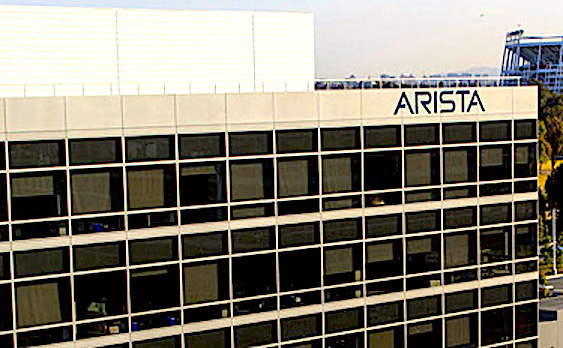 INFRA
INFRA
 INFRA
INFRA
 INFRA
INFRA
High-frequency trading markets have relied on 10G infrastructure for more than a decade, and Arista Networks Inc. has been at the forefront, providing essential equipment to financial institutions such as trading firms and exchanges.
In fact, it was almost 20 years ago that Arista was founded to provide networking products to the financial industry. Its ability to build products for this demanding industry was what put it on the map, since customers felt if it could serve that demanding industry, its products could be used anywhere.
However, with the rapid increase in market data volumes, 10G infrastructure is proving insufficient. To meet the growing needs of financial institutions, Arista today launched its latest 7130 Series, specifically designed for HFT with speeds of 25G for market data distribution.
Institutions looking to upgrade to 25G will find the migration smooth without abandoning their existing 10G systems, explained Martin Hull, vice president of cloud and platform product management at Arista. In fact, many back-end systems already operate on 25G, making the shift to 25G in frontline networks a logical next step.
In the networking industry, 25G is a relatively recent development that emerged as an interim standard between the already-established 10G and the high-speed 40G and 100G standards. For over a decade, financial institutions have relied heavily on 10G. But with market data volumes soaring at unprecedented rates, 10G is starting to falter. Data spikes and microbursts, in particular, are laying bare the limitations of the current infrastructure, forcing the shift to more robust bandwidth solutions.
One might wonder why the financial institutions haven’t already moved to higher speeds, and the answer to that lies in the subtleties of switching design. A 10G connection is one pipe operating at 10G. A 40G connection, under the covers, is actually 4x10G, so that introduces a small bit of latency, and in HFT, latency is a killer. The 25G ports are a single pipe, offering faster speeds with minimal latency.
With this announcement, Arista is releasing three new devices in the 7130 Series: 7132LB, 7135LB, and 7130B-32YD. The switches are designed to enhance network performance by significantly increasing bandwidth and reducing latency. In tandem with this, Arista is broadening its arsenal of field-programmable gate array applications to fully support 25G solutions. Arista released an updated version of its FPGA Developer’s Kit, giving customers a comprehensive solution.
Each device caters to specific use cases within the financial trading realm:
One of the major hurdles in migrating to 25G is optics. The IEEE’s introduction of Forward Error Correction, or FEC, for 25G optics, while helpful in many respects, added unwanted latency. FEC improves reliability by detecting and correcting errors in retransmitting dropped packets, which requires additional time and logic adding up to 250 nanoseconds of latency.
But in HFT, there is no value in adding latency for greater reliability: Market data information needs to be as close to live as possible. FEC has greatly improved network reliability and performance for most use cases but is ineffective for real-time trading.
Arista’s 25G enhanced performance optics are a noteworthy addition, potentially making networks about 2.5 times faster. This increase in speed is thanks to the combined effects of reduced queuing, serialization delays and the strategic omission of FEC. Unlike conventional 25G optics, which require FEC and add approximately 250 nanoseconds of latency, Arista’s iteration functions without FEC.
“We can upgrade the layer one infrastructure to 25G and unleash the potential of those other general-purpose networks,” said Hull. “It’s getting harder and harder for us to make new 10G data center switches, which is increasingly becoming a legacy speed. So, there are many reasons to move to this higher speed.”
Technically speaking, the benefits are compelling. On a 10G network, a frame’s transmission requires around 400 nanoseconds. In contrast, it takes only 163 nanoseconds on a 25G network, resulting in a time-saving of 237 nanoseconds per frame. This decrease means traders receive market data faster, offering a distinct advantage, especially when competing against those still operating at 10G.
In essence, Arista’s move to 25G, backed by a comprehensive ecosystem of switches, FPGAs, applications and software development kits, answers the industry’s call for a significant upgrade. The advantages of 25G, including reduced latency, better traffic management and enhanced compatibility, are undeniable, according to Hull. As financial markets evolve, embracing 25G will not only be beneficial, but it will set the stage for the future of trading.
Zeus Kerravala is a principal analyst at ZK Research, a division of Kerravala Consulting. He wrote this article for SiliconANGLE.
Support our mission to keep content open and free by engaging with theCUBE community. Join theCUBE’s Alumni Trust Network, where technology leaders connect, share intelligence and create opportunities.
Founded by tech visionaries John Furrier and Dave Vellante, SiliconANGLE Media has built a dynamic ecosystem of industry-leading digital media brands that reach 15+ million elite tech professionals. Our new proprietary theCUBE AI Video Cloud is breaking ground in audience interaction, leveraging theCUBEai.com neural network to help technology companies make data-driven decisions and stay at the forefront of industry conversations.